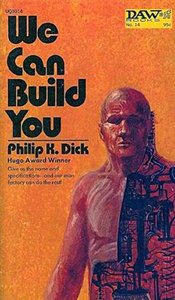Philip K. Dick melds three ideas into one book in “We Can Build You” (written in 1962, published in 1972), but it flows better than overstuffed efforts such as “Dr. Futurity” and “The Game-Players of Titan.” While this is certainly a sci-fi novel, a lot of the sci-fi is silly and/or unnecessary, as if PKD is satisfying an editorial directive to add futuristic elements. An exception is the existence of simulacra of Edward M. Stanton and Abraham Lincoln, who aren’t treated as jokes.
Rosen’s POV
Set in the near-future (at the time) of 1982, “We Can Build You” would be a good foundational work to read before PKD’s more reality-bending mind trips such as “Martian Time-Slip” because it gives a clear description of schizophrenia. A big part of the book’s clarity comes from the fact that we get the first-person point of view of small-businessman Louis Rosen.
Based in Ontario, Ore., Rosen is initially concerned with issues such as the struggling piano branch of his company and the possibility of opening up a new market in simulacra sales. His partner, Maury Rock, has constructed a simulacrum of Civil War official Stanton with the help of his once-schizophrenic, now-cured daughter, Pris Frauenzimmer. While robots already exist, a re-creation of a specific person is a new thing.

One of the funnier moments is when Louis and Maury haul around the Stanton by wrapping it in newspapers and sticking it in the backseat. Leave it to PKD to imagine a future that includes robots that are indistinguishable from humans (and which run on reel-to-reel tapes), rocket ships and mutants with upside-down faces … and also print newspapers. Well, one of those four things was true when the actual 1982 rolled around.
The simulacra are the first of the three big ideas, and “We Can Build You” briefly reads like a “Frankenstein” update, except that instead of going out and causing mayhem, Stanton and Lincoln behave like normal humans.
Given PKD’s professed beliefs that replicants are not equal to humans (a point of 1968’s “Do Androids Dream of Electric Sheep” that became overshadowed by “Blade Runner’s” opposite take), it’s interesting to note that he portrays the duo in entirely human fashion here. Indeed, Lincoln and Rosen become good friends, as they are both depressive. (PKD seems to admire the real Lincoln and sympathize with his tough decisions in office, but he also includes the fact that Lincoln viewed blacks as an inferior race, something that many Honest Abe fans skim over.)
Corporate ethics
The narrative mayhem instead comes from the book’s second big theme, corporate ethics. Big-shot Seattle businessman Samuel Barrows is looking to purchase the simulacra from this mom-and-pop Oregon outfit, but he thinks money will not be made from Civil War re-enactments but instead in a convoluted and perhaps unethical way. He wants to have the simulacra settle on his properties on the moon, thus showing humans that it’s a good place to live.

Although it’s not pointless to go through those stretches of the novel, PKD isn’t aiming for a grand statement about the humanity of robots nor of corporate tactics. Instead, he’s interested in Rosen’s schizophrenia and his unrequited love for Pris. This third big idea is the last to emerge, and it’s what ultimately defines “We Can Build You” (even though it will always be “the one with the Abe Lincoln robot” in casual conversation).
PKD does a masterful job of showing Rosen gradually falling in love with Pris – whom I picture as Daryl Hannah’s replicant by that name in “Blade Runner,” and that’s close to PKD’s physical description – and the way she generally rejects him but sometimes gives him hope that she loves him back.
She’s obviously a genius since she is a key contributor in building completely lifelike robots, but like a lot of artistic types, she is mentally unstable. This personality type is catnip to the likewise unstable Rosen. (Plus, since PKD is at the typewriter, Pris’ small yet perky breasts play into Rosen’s attraction too. But not relentlessly.)
Gradually, Rosen moves farther into an alternate schizophrenic world where he’s married to Pris — although not exactly happily, since she still behaves in the same maddening way toward him. Being rejected even in a dream reality of your own making – now that’s some vintage PKD right there.
Reality and unreality
Unlike in many of PKD’s works, here it is clear when Rosen is in reality and when he is not; the doctors at a clinic in Kansas City purposely induce fugue states in order to study and help their patient. The author often shows distrust of governments in his writing, but he makes a notable exception for government-backed science here.
Rosen more than once admires the fact that he’s being helped by federal funding and a law, the McHeston Act, which mandates treatment for people with mental illness. He portrays the facility and doctors as being excellent, with the only drawback being overcrowding.
PKD passes on all the whiz-bang endings “We Can Build You” could’ve had, leaving the simulacra and corporate rivalry threads in the dust. He doesn’t even go with a wacky multiple-worlds trek for Rosen, nor does he go into the human-robot identity mysteries later found in “Do Androids Dream of Electric Sheep.”
It’s apparent that “We Can Build You” was somewhat of a trial run for “DADOES,” given the use of names like Pris and Rosen. This novel also includes psychological-analysis tests called the Benjamin Proverb Test and the Vigotsky-Luria Block Test. Perhaps these led in PKD’s mind toward the Voigt-Kampf Test, which identifies androids. And the mood organ gets mentioned; it’s crushing piano sales in the marketplace.
Even though he sets those meaty ideas aside for later, I appreciate how clearly PKD portrays Rosen’s mental-health condition and his unrequited love. Despite a few instances of gleefully goofball sci-fi and the juggling of two other concepts that could’ve been their own book, “We Can Build You” is ultimately an easy-to-absorb exploration of one man’s mental illness.
It’s not PKD’s most out-there book, but it’s interesting to get his political viewpoint on mental health and to read a rare novel where he’s perfectly fine with robots rather than being wary of them.

